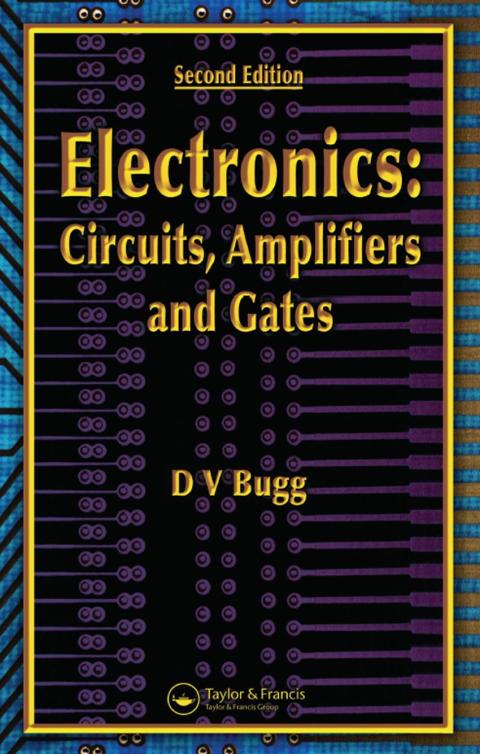Description
Efnisyfirlit
- Cover
- Half Title
- Title Page
- Copyright Page
- Preface
- Table of Contents
- 1 Voltage, Current and Resistance
- 1.1 Basic Notions
- 1.2 Waveforms
- 1.3 Ohm’s Law
- 1.4 Diodes
- 1.5 Kirchoff’s Laws
- 1.6 Node Voltages
- 1.7 EARTHS
- 1.8 Superposition
- 1.9 Summary
- 1.10 Exercises
- 2 Thevenin and Norton
- 2.1 Thevenin’s Theorem
- 2.2 How to Measure VEQ and REQ
- 2.3 Current Sources
- 2.4 Norton’s Theorem
- 2.5 General Remarks on Thevenin’s Theorem and Norton’s
- 2.6 Matching
- 2.7 Amplifiers
- 2.8 Systems
- 2.9 Summary
- 2.10 Exercises
- 3 Capacitance
- 3.1 Charge and Capacitance
- 3.2 Energy Stored in a Capacitor
- 3.3 The Effect of a Dielectric
- 3.4 Capacitors in Parallel
- 3.5 Capacitors in Series
- 3.6 The CR Transient
- 3.7 AC Coupling and Baseline Shift
- 3.8 Stray Capacitance
- 3.9 Integration and Differentiation
- 3.10 Thevenin’s Theorem Again
- 3.11 Summary
- 3.12 Exercises
- 4 Alternating Current (AC); Bandwidth
- 4.1 Introduction
- 4.2 Power in a Resistor: RMS Quantities
- 4.3 Phase Relations
- 4.4 Response of a Capacitor to AC
- 4.5 Simple Filter Circuits
- 4.6 Power Factor
- 4.7 Amplifiers
- 4.8 Bandwidth
- 4.9 Noise and Bandwidth
- 4.10 Summary
- 4.11 Exercises
- 5 Inductance
- 5.1 Faraday’s law
- 5.2 Self-inductance
- 5.3 LR Transient
- 5.4 Energy Stored in an Inductor
- 5.5 Stray Inductance
- 5.6 Response of an Inductor to Alternating Current
- 5.7 Phasors
- 5.8 Summary
- 5.9 Exercises
- 6 Complex Numbers: Impedance
- 6.1 Complex Numbers
- 6.2 AC Voltages and Currents
- 6.3 Inductance
- 6.4 Summary on Impedance
- 6.5 Impedances in Series
- 6.6 Impedances in Parallel
- 6.7 Power
- 6.8 Bridges
- 6.9 Exercises
- 7 Operational Amplifiers and Negative Feedback
- 7.1 Introduction
- 7.2 Series Voltage Feedback
- 7.3* Approximations in Voltage Feedback
- 7.4 Shunt Feedback
- 7.5 The Analogue Adder
- 7.6 The Differential Amplifier
- 7.7 Gain-Bandwidth Product
- 7.8 Offset Voltage and Bias Current
- 7.9 Complex Feedback Loops
- 7.10 Impedance Transformation
- 7.11 Input and Output Impedances with Feedback
- 7.12 Stabilized Current Supplies
- 7.13* Input Impedance with Shunt Feedback
- 7.14 Oscillation.
- 7.15 Exercises
- 8 Integration and Differentiation
- 8.1 Integration
- 8.2 The Miller Effect
- 8.3 Compensation
- 8.4 Differentiation
- 8.5 The Charge Sensitive Amplifier
- 8.6 Exercises
- 9 The Diode and the Bipolar Transistor
- 9.1 Conductors
- 9.2 Semiconductors and Doping
- 9.3 The pn Junction Diode
- 9.4 The Diode as a Switch
- 9.5 The npn Bipolar Transistor
- 9.6 Simple Transistor Circuits
- 9.7 Voltage Amplification
- 9.8 Biasing
- 9.9 Exercises
- 10 The Field-Effect Transistor (FET)
- 10.1 Gate Action
- 10.2 Simple FET Amplifiers
- 10.3 MOSFETs
- 10.4 Fabrication of Transistors and Integrated Circuits
- 10.5 CMOS
- 11 Equivalent Circuits for Diodes and Transistors
- 11.1 Introduction: the Diode
- 11.2 An Equivalent Circuit for the Bipolar Transistor
- 11.3 The Hybrid-π Equivalent Circuit
- 11.4 The FET
- 11.5 The Common Emitter Amplifier
- 11.6 Performance of the Common Emitter Amplifier
- 11.7 Emitter Follower
- 11.8 FETs
- 11.9 Exercises
- 12 Gates
- 12.1 Introduction
- 12.2 Logical Combinations of A and B
- 12.3 Boolean Algebra
- 12.4 De Morgan’s Theorems
- 12.5 The Full Adder
- 12.6 The Karnaugh Map
- 12.7 Don’t Care or Can’t Happen Cobnditions
- 12.8 Products of Karnaugh Maps
- 12.9 Products of Sums
- 12.10 Use of NOR and NAND Gates
- 12.11 Decoders and Encoders
- 12.12 Multiplexing
- 12.13 Exercises
- 13 Sequential Logic
- 13.1 The RS Flip-Flop
- 13.2 Clocks
- 13.3 The JK Flip-Flop
- 13.4 A Scale-of-4 Counter
- 13.5 State Diagrams
- 13.6 Trapping Sequences: Pattern Recognition
- 13.7 The Monostable
- 13.8 The Pulse Generator
- 13.9 Exercises
- 14 Resonance and Ringing
- 14.1 Introduction
- 14.2 Resonance in a Series LCR Circuit
- 14.3 Transient in a CL Circuit
- 14.4 Transient in the Series LCR Circuit
- 14.5 Parallel LCR
- 14.6* Poles and Zeros
- 14.7 Exercises
- 15 Fourier’s Theorem
- 15.1 Introduction
- 15.2 A Square Wave applied to a CR Filter
- 15.3 How to Find Fourier Coefficients
- 15.4 The Heterodyne Principle
- 15.5 Broadcasting
- 15.6 Frequency Modulation (FM)
- 15.7 Frequency Multiplexing
- 15.8 Time Division Multiplexing
- 15.9 Fourier Series Using Complex Exponentials
- 15.10 Fourier Transforms
- 15.11 Response to an Impulse
- 15.12 Fourier Analysis of a Damped Oscillator
- 15.13 The Perfect Filter
- 15.14 Exercises
- 16 Transformers and Three-Phase Supplies
- 16.1 Introduction
- 16.2 Energy Stored in a Transformer
- 16.3 Circuit Equations and Equivalent Circuits
- 16.4 Three-Phase Systems
- 16.5 Balanced Loads
- 16.6 Exercises
- Appendix A Thevenin’s Theorem
- Appendix B Exponentials
- Index






Reviews
There are no reviews yet.